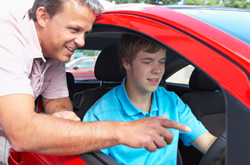
The first years teenagers spend as drivers are very risky. Motor vehicle crashes are the leading cause of death among 15- to 20-year-olds and research shows that more than half of teens who die in crashes are passengers, most of whom are not wearing a seatbelt.
Immaturity and lack of driving experience are the two main factors leading to the high crash rates among teens. Even the best teenage drivers do not have the judgment that comes from experience. It affects their recognition of, and response to, hazardous situations and results in dangerous practices such as speeding and tailgating.
Teens also tend to engage in risky behavior—eating, talking on their cellphones, text messaging, talking to friends in the car—and they often do not wear their seat belts.
While getting a drivers license is an exciting rite-of-passage for teens, it can make a parent frantic. The Insurance Information Institute recommends parents take the following steps to ensure the safety of their teen.
#1 - Pick a Safe Car
You and your teenager should choose a car that is easy to drive and would offer protection in the event of a crash. Avoid small cars and those with high performance images that might encourage speed and recklessness. Trucks and sport utility vehicles (SUVs) should also be avoided, since they are more prone to rollovers.
#2 - Enroll Your Teen in a Drivers Education Course
The more driving practice the better; experience will give your teen confidence behind the wheel, and he or she will be better able to react to challenging situations on the road.
Furthermore, a teenager who has learned to drive through a recognized drivers education course is viewed more favorably by insurers and may earn a discount. In some states, teens must take a drivers education course if they want to get a license at age 16; otherwise, they have to wait until they are 18.
#3 - Enroll Your Teen in a Safe Driver Program

Check whether your insurance company offers a “safe driver” program. Teen participants in these programs sign parent-teen driving contracts that outline the young driver’s responsibilities (for instance, not having teen passengers in the car, being home by a certain hour, etc) and the consequences of failure to meet those expectations.
Check whether your insurance company has such a program—if your teenager completes the program, you may be eligible for a discount.
In addition, insurance companies are helping to reduce the number of accidents involving teen drivers by subsidizing the cost of electronic devices, such as GPS systems and video cameras, which can monitor the way teens drive and alert parents of unsafe driving practices by email, text message or phone.
#4 - Discuss the Dangers of Drug and Alcohol Use
Advise teens never to drink or do drugs, and not to get in a car if the driver has used drugs or alcohol. Encourage your teen to call you if such a situation arises to ensure they have a safe way home.
#5 - Understand the Dangers of Distracted and Impaired Driving
Talk to your teen about the importance of never phoning or texting while driving, and keeping distractions, such as the radio and chatting with friends to a minimum. Teens should also be responsible passengers when in their friends’ cars. New drivers should wait 1,000 miles or six months before picking up their first teen passenger.
#6 - Be a Good Role Model
New drivers learn by example, so if you drive recklessly, your teenage driver may imitate you. Always wear your seatbelt and never drink and drive.
#7 - Enroll Your Teen in a Graduated Drivers License Program—or Create Your Own

Many states have been successful in reducing teen accidents by enacting graduated drivers license (GDL) legislation. These laws, which include a three-phase program, allow teen drivers to develop more mature driving attitudes and gain experience behind the wheel.
New drivers are restricted from certain activities, such as late-night driving or having passengers in the car, until they have had their licenses for a set period.
A number of states also restrict the amount of time new drivers may be on the road without supervision. For more information on GDLs, visit www.iihs.org.
Parents should take an active role in their teenagers’ driving practice and expose them to driving in a wide variety of driving conditions to build experience and confidence. If your state does not have a GDL program, you can institute the same policies with your own children. Introduce privileges gradually. Allow independent driving only after continued practice, including night driving and driving in inclement weather.
Keep in mind, teens do not all reach the appropriate level of maturity to handle a drivers license at the same time. Parents should consider whether teens are easily distracted, nervous or risk takers before allowing them to get a license or even a learners permit.
Content courtesy of iii.org.
